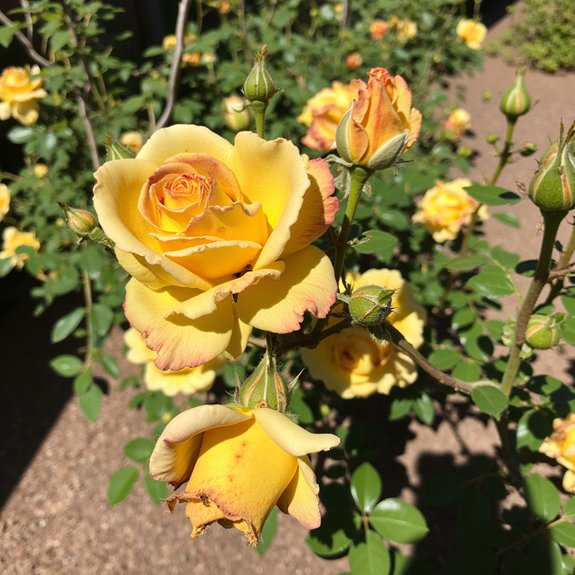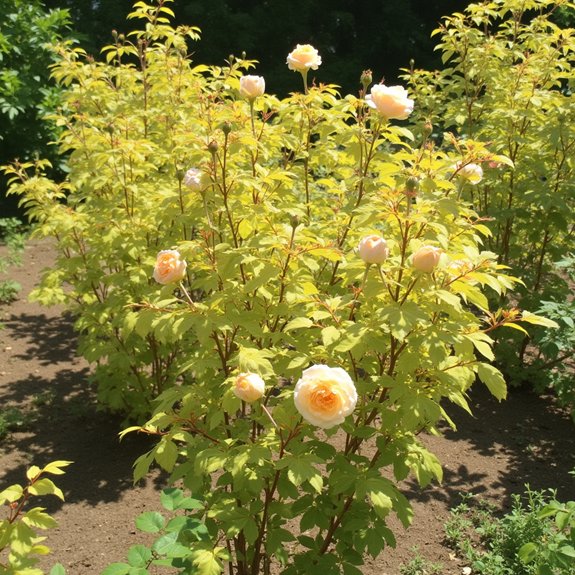You’ve checked the watering schedule, you’ve inspected for bugs, and you’ve examined the soil—yet your roses keep turning yellow. Whether it’s inadequate sunlight, temperature swings, or hidden nutrient deficiencies, yellowing leaves signal that something’s disrupting your plant’s normal processes. The culprit might be obvious, or it could be lurking beneath the surface in ways you haven’t considered.
Contents
Insufficient Sunlight Exposure

When roses don’t receive adequate sunlight, their leaves often turn yellow as the plant struggles to produce enough energy through photosynthesis. Your roses need 6-8 hours of direct sunlight daily to thrive, and understanding proper sunlight requirements is vital for healthy growth.
Dense foliage from surrounding plants can create unwanted shade, blocking essential light from reaching your rose’s lower leaves. Effective shade management involves trimming nearby vegetation to increase light exposure. If that doesn’t solve the problem, consider relocating your rose to a sunnier location during early spring when the plant is dormant and less likely to experience transplant shock.
Improper Watering Practices
Because roses are particularly sensitive to water levels, both overwatering and underwatering can trigger yellow leaves that signal distress. Overwatering creates soggy roots that can’t absorb nutrients properly, while underwatering stresses plants into survival mode.
Your watering frequency should deliver 2-4 gallons weekly through deep, infrequent sessions rather than daily sprinkles. Poor soil drainage compounds overwatering problems, so amend heavy clay with organic compost.
During drought conditions, increase watering to twice weekly and apply mulch to retain moisture. Look for brown leaf edges, which indicate drought damage, versus wilting from waterlogged conditions.
Heat Stress and Temperature Extremes

While roses love sunshine, temperatures above 85°F can push these beautiful plants into stress mode, especially if they’ve been recently transplanted. High heat causes droopy plants, small blooms, and those telltale yellow leaves you’re seeing.
When temperatures consistently hit 95°F or higher, photosynthesis struggles, and your roses can’t function properly. Temperature fluctuations between scorching days and cooler nights add extra stress.
Effective heat management involves choosing locations with morning sun and afternoon shade. Apply mulch around the base to keep roots cool and shaded, creating a buffer against extreme temperatures.
Foliar Diseases and Infections
Beyond environmental stressors, your roses might be battling fungal or viral infections that create distinctive yellowing patterns across the leaves. Black spot disease produces telltale black or brown splotches surrounded by yellow halos, thriving in wet, humid conditions. Rose mosaic virus creates bright yellow mottled patterns with unique designs across foliage. Regular leaf inspection helps catch these issues early, though there’s no cure once infected. Disease prevention focuses on removing affected foliage immediately and ensuring proper air circulation. Unfortunately, you’ll need to focus on prevention rather than treatment for these persistent problems.
Nutrient Deficiencies and Soil Issues

When your rose’s roots can’t access essential nutrients from the soil, yellowing leaves often serve as the plant’s distress signal. Nitrogen deficiency creates pale yellow leaves, while iron deficiency causes yellowing between leaf veins. Soil testing reveals what’s missing and guides your fertilization strategies.
Soil pH matters greatly. Above 6.5, iron becomes locked out; below 6.0, nitrogen availability drops. Use balanced fertilizers for general deficiencies. Address iron issues with liquid chelated iron products, and boost nitrogen with blood meal or coffee grounds. Test your soil annually to maintain ideal nutrient levels.
Pest Infestations and Damage
If you notice tiny insects crawling on your roses or webbing under the leaves, pest infestations might be causing those yellow leaves. Common culprits include aphids, spider mites, and whiteflies that stress plants and drain nutrients. Effective pest identification techniques involve checking leaf undersides for sticky webs, tiny moving dots, or clusters of small bugs.
Spider mites thrive in hot, dry conditions, creating bronze and yellow foliage with telltale webbing. Knock them off with strong water sprays, then keep plants well-hydrated. Organic pest solutions like insecticidal soap or neem oil work effectively without harming beneficial insects that naturally control these pests.
Soil Ph Imbalances
While pests can wreak havoc on your roses, soil pH problems often fly under the radar as a major culprit behind yellowing leaves. Your roses prefer slightly acidic soil between 6.0-6.8 pH. When pH climbs too high, nutrients get locked out, leaving your plants starving despite adequate fertilization.
Soil testing reveals the true story behind those yellow leaves. High pH prevents iron and nitrogen uptake, causing that telltale yellowing pattern. pH adjustment becomes essential for recovery.
Lower acidic soil by adding sulfur or organic matter like compost. This simple fix often transforms struggling roses back to their vibrant green glory.
Environmental Stressors and Chemical Damage
Have you considered that your roses might be victims of environmental stress rather than disease? Transplant shock commonly causes yellowing leaves after relocation, especially during weather changes. Your roses need time to establish their roots in new soil.
Herbicide damage creates particularly telling symptoms. You’ll notice small, yellow, oddly-shaped new leaves that appear twisted with deformed buds. Glyphosate and broad-leaf herbicides often drift from neighboring applications, affecting your roses without direct spraying.
If you suspect herbicide damage, avoid fertilizing until normal growth resumes. Keep plants well-watered during recovery, and consider manual weed removal instead.
